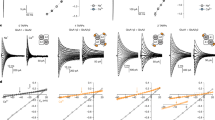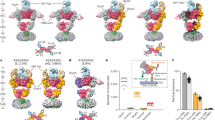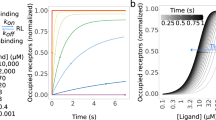Abstract
Cells preferentially expressing GluR4-containing α-amino-3-hydroxy-5-methyl-4-isoxazole-propionic acid (AMPA) receptors are particularly sensitive to excitotoxicity mediated through non-N-methyl-D-aspartate receptors. However, the excitotoxic signalling pathways associated with GluR4-containing AMPA receptors are not known. In this work, we investigated the downstream signals coupled to excitotoxicity mediated by Ca2+-permeable GluR4-containing AMPA receptors, using a HEK 293 cell line constitutively expressing the GluR4flip subunit of AMPA receptors (HEK-GluR4). Glutamate stimulation of GluR4-containing AMPA receptors decreased cell viability, in a calcium-dependent manner, when the receptor desensitisation was prevented with cyclothiazide. The excitotoxic stimulation mediated through GluR4-containing AMPA receptors increased activator protein-1 (AP-1) DNA-binding activity. Inhibition of the AP-1 activity by overexpression of a c-Jun dominant-negative form protected HEK-GluR4 cells against excitotoxic damage. Taken together, the results indicate that overactivation of Ca2+-permeable GluR4-containing AMPA receptors is coupled to a death pathway mediated, at least in part, by the AP-1 transcription factor.
Similar content being viewed by others
Log in or create a free account to read this content
Gain free access to this article, as well as selected content from this journal and more on nature.com
or
Abbreviations
- HEK:
-
human embrionic kidney
- AMPA:
-
α-amino-3-hydroxy-5-methyl-4-isoxazole-propionic acid
- KA:
-
kainate
- NMDA:
-
N-methyl-D-aspartate
- GluR:
-
glutamate receptor
- CNQX:
-
6-cyano-7-nitroquinoxaline-2,3-dione
- CTZ:
-
cyclothiazide
- MTT:
-
3-(4,5-dimethylthiazol-2-yl)-2,5-diphenyl Tetrazolium bromide
- PBS:
-
phosphate buffered saline
- AP-1:
-
activator protein-1
- dn c-Jun:
-
c-Jun dominant negative
- JNK:
-
c-Jun N-terminal kinase
- MLK:
-
mixed lineage kinase
- ATF2:
-
activating transcription factor 2
- PSD:
-
postsynaptic density
- ALS:
-
amyotrophic lateral sclerosis
References
Sattler R and Tymianski M (2000) Molecular mechanisms of calcium-dependent excitotoxicity. J. Mol. Med. 78: 3–13
Dingledine R, Borges K, Bowie D and Traynelis SF (1999) The glutamate receptor ion channels. Pharmacol. Rev. 51: 7–61
Ferreira IL, Duarte CB and Carvalho AP (1996) Ca2+ influx through glutamate receptor-associated channels in retina cells correlates with neuronal cell death. Eur. J. Pharmacol. 302: 153–162
Santos AE, Carvalho AL, Lopes MC and Carvalho AP (2001) Differential postreceptor signalling events triggered by excitotoxic stimulation of different ionotropic glutamate receptors in retinal neurons. J. Neurosci. Res. 66: 643–655
Hardingham GE, Fukunaga Y and Bading H (2002) Extrasynaptic NMDARs oppose synaptic NMDARs by triggering CREB shut-off and cell death pathways. Nat. Neurosci. 5: 405–414
Madden DR (2002) The structure and function of glutamate receptor ion channels. Nat. Rev. Neurosci. 3: 91–101
Seeburg PH (1996) The role of RNA editing in controlling glutamate receptor channel properties. J. Neurochem. 66: 1–5
Gorter JA, Petrozzino JJ, Aronica EM, Rosenbaum DM, Opitz T, Bennett MV, Connor JA and Zukin RS (1997) Global ischemia induces downregulation of GluR2 mRNA and increases AMPA receptor-mediated Ca2+ influx in hippocampal CA1 neurons of gerbil. J. Neurosci. 17: 6179–6188
Liu S, Lau L, Wei JS, Zhu DY, Zou S, Sun HS, Fu YP, Liu F and Lu YM (2004) Expression of Ca2+-permeable AMPA receptor channels primes cell death in transient forebrain ischemia. Neuron 43: 43–55
Van Den Bosch L, Vandenberghe W, Klaassen H, Van Houtte E and Robberecht W (2000) Ca2+-permeable AMPA receptors and selective vulnerability of motor neurons. J. Neurol. Sci. 180: 29–34
Kawahara Y, Ito K, Sun H, Aizawa H, Kanazawa I and Kwak S (2004) RNA editing and death of motor neurons. Nature 427: 801
Yin HZ, Lindsay AD and Weiss JH (1994) Kainate injury to cultured basal forebrain cholinergic neurons is Ca2+ dependent. Neuroreport 5: 1477–1480
Page KJ and Everitt BJ (1995) The distribution of neurons coexpressing immunoreactivity to AMPA-sensitive glutamate receptor subtypes (GluR1-4) and nerve growth factor receptor in the rat basal forebrain. Eur. J. Neurosci. 7: 1022–1033
Vandenberghe W, Bindokas VP, Miller RJ, Robberecht W and Brorson JR (2001) Subcellular localization of calcium-permeable AMPA receptors in spinal motoneurons. Eur. J. Neurosci. 14: 305–314
Carvalho AL, Correia S, Faro CJ, Duarte CB, Carvalho AP and Pires EM (2002) Phosphorylation of GluR4 AMPA-type glutamate receptor subunit by protein kinase C in cultured retina amacrine neurons. Eur. J. Neurosci. 15: 465–474
Shaulian E and Karin M (2002) AP-1 as a regulator of cell life and death. Nat. Cell Biol. 4: E131–E136
Behrens A, Sibilia M and Wagner EF (1999) Amino-terminal phosphorylation of c-Jun regulates stress-induced apoptosis and cellular proliferation. Nat. Genet. 21: 326–329
Yang DD, Kuan CY, Whitmarsh AJ, Rincon M, Zheng TS, Davis RJ, Rakic P and Flavell RA (1997) Absence of excitotoxicity-induced apoptosis in the hippocampus of mice lacking the Jnk3 gene. Nature 389: 865–870
Borsello T, Clarke PGH, Hirt L, Vercelli A, Repici M, Schorderet DF, Bogouslavsky J and Bonny C (2003) A peptide inhibitor of c-Jun N-terminal kinase protects against excitotoxicity and cerebral ischemia. Nat. Med. 9: 1180–1186
Kuan CY, Whitmarsh AJ, Yang DD, Liao G, Schloemer AJ, Dong C, Bao J, Banasiak KJ, Haddad GG, Flavell RA, Davis RJ and Rakic P (2003) A critical role of neural-specific JNK3 for ischemic apoptosis. Proc. Natl. Acad. Sci. USA 100: 15184–15189
Iizuka M, Nishimura S, Wakamori M, Akiba I, Imoto K and Barsoumian EL (2000) The lethal expression of the GluR2flip/GluR4flip AMPA receptor in HEK293 cells. Eur. J. Neurosci. 12: 3900–3908
Swanson GT, Kamboj SK and Cull-Candy SG (1997) Single-channel properties of recombinant AMPA receptors depend on RNA editing, splice variation, and subunit composition. J. Neurosci. 17: 58–69
Tomiyama M, Rodriguez-Puertas R, Cortes R, Pazos A, Palacios JM and Mengod G (2002) Flip and flop splice variants of AMPA receptor subunits in the spinal cord of amyotrophic lateral sclerosis. Synapse 45: 245–249
Mosbacher J, Schoepfer R, Monyer H, Burnashev N, Seeburg PH and Ruppersberg JP (1994) A molecular determinant for submillisecond desensitization in glutamate receptors. Science 266: 1059–1062
Ankarcrona M, Dypbukt JM, Bonfoco E, Zhivotovsky B, Orrenius S, Lipton SA and Nicotera P (1995) Glutamate-induced neuronal death: a succession of necrosis or apoptosis depending on mitochondrial function. Neuron 15: 961–973
Lerea LS, Butler LS and McNamara JO (1992) NMDA and non-NMDA receptor-mediated increase of c-fos mRNA in dentate gyrus neurons involves calcium influx via different routes. J. Neurosci. 12: 2973–2981
Griffiths R, Ritchie L, Lidwell K, Grieve A, Malcolm CS, Scott M and Meredith C (1998) Calcium influx via L-type voltage-gated channels mediates the delayed, elevated increases in steady-state c-fos mRNA levels in cerebellar granule cells exposed to excitotoxic levels of glutamate. J. Neurosci. Res. 52: 641–652
Ham J, Babij C, Whitfield J, Pfarr CM, Lallemand D, Yaniv M and Rubin LL (1995) A c-Jun dominant negative mutant protects sympathetic neurons against programmed cell death. Neuron 14: 927–939
Weiss JH, Yin HZ and Choi DW (1994) Basal forebrain cholinergic neurons are selectively vulnerable to AMPA/kainate receptor-mediated neurotoxicity. Neuroscience 60: 659–664
Chen Q, Olney JW, Price MT and Romano C (1999) Biochemical and morphological analysis of non-NMDA receptor mediated excitotoxicity in chick embryo retina. Vis. Neurosci. 16: 131–139
Carvalho AL, Duarte CB, Faro CJ, Carvalho AP and Pires EV (1998) Calcium influx through AMPA receptors and through calcium channels is regulated by protein kinase C in cultured retina amacrine-like cells. J. Neurochem. 70: 2112–2119
Utz AL and Verdoorn TA (1997) Recombinant AMPA receptors with low Ca2+ permeability increase intracellular Ca2+ in HEK 293 cells. Neuroreport 8: 1975–1980
Kaminska B, Filipkowski RK, Zurkowska G, Lason W, Przewlocki R and Kaczmarek L (1994) Dynamic changes in the composition of the AP-1 transcription factor DNA-binding activity in rat brain following kainate-induced seizures and cell death. Eur. J. Neurosci. 6: 1558–1566
Schwarzschild MA, Cole RL and Hyman SE (1997) Glutamate, but not dopamine, stimulates stress-activated protein kinase and AP-1-mediated transcription in striatal neurons. J. Neurosci. 17: 3455–3466
Hou YN, Cebers G, Terenius L and Liljequist S (1997) Characterization of NMDA- and AMPA-induced enhancement of AP-1 DNA binding activity in rat cerebellar granule cells. Brain Res. 754: 79–87
Finiels F, Robert JJ, Samolyk ML, Privat A, Mallet J and Revah F (1995) Induction of neuronal apoptosis by excitotoxins associated with long-lasting increase of 12-O-tetradecanoylphorbol 13-acetate-responsive element-binding activity. J. Neurochem. 65: 1027–1034
Whitfield J, Neame SJ, Paquet L, Bernard O and Ham J (2001) Dominant-negative c-Jun promotes neuronal survival by reducing BIM expression and inhibiting mitochondrial cytochrome c release. Neuron 29: 629–643
Savinainen A, Garcia EP, Dorow D, Marshall J and Liu YF (2001) Kainate receptor activation induces mixed lineage kinase-mediated cellular signalling cascades via post-synaptic density protein 95. J. Biol. Chem. 276: 11382–11386
Aarts M, Liu Y, Liu L, Besshoh S, Arundine M, Gurd JW, Wang YT, Salter MW and Tymianski M (2002) Treatment of ischemic brain damage by perturbing NMDA receptor- PSD-95 protein interactions. Science 298: 846–850
Bonfoco EAM, Krainc D, Nicotera P and Lipton S (1997) Techniques for distinguishing apoptosis from necrosis in cerebrocortical and cerebellar neurons. In Neuromethods: Apoptosis Techniques and Protocols, Poirier J ed (New Jersey: Humana Press) pp. 237–253
Acknowledgements
We thank Professor Caetana M Carvalho for the numerous suggestions and for the critical reading of the manuscript. This work was supported by the Portuguese Science Foundation (FCT) FEDER, and by the Bissaya Barreto Foundation.
Author information
Authors and Affiliations
Corresponding author
Additional information
Edited by P Nicotera
Rights and permissions
About this article
Cite this article
Santos, A., Duarte, C., Iizuka, M. et al. Excitotoxicity mediated by Ca2+-permeable GluR4-containing AMPA receptors involves the AP-1 transcription factor. Cell Death Differ 13, 652–660 (2006). https://doi.org/10.1038/sj.cdd.4401785
Received:
Revised:
Accepted:
Published:
Issue date:
DOI: https://doi.org/10.1038/sj.cdd.4401785
Keywords
This article is cited by
-
AMPA-ergic regulation of amyloid-β levels in an Alzheimer’s disease mouse model
Molecular Neurodegeneration (2018)
-
Excessive activation of ionotropic glutamate receptors induces apoptotic hair-cell death independent of afferent and efferent innervation
Scientific Reports (2017)
-
Bidirectional plasticity of calcium-permeable AMPA receptors in oligodendrocyte lineage cells
Nature Neuroscience (2011)
-
PICK1-mediated GluR2 endocytosis contributes to cellular injury after neuronal trauma
Cell Death & Differentiation (2009)



